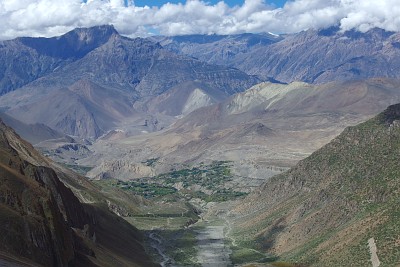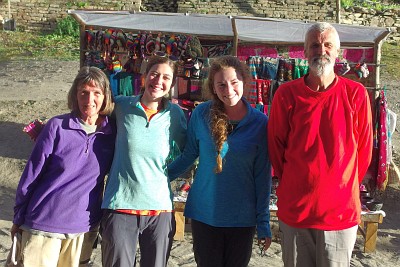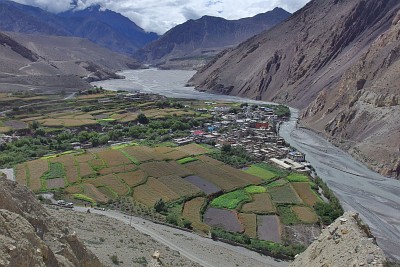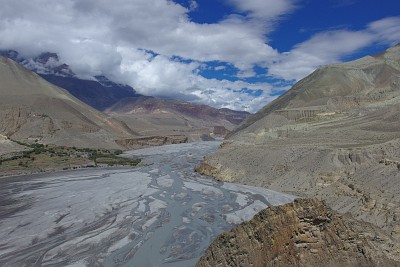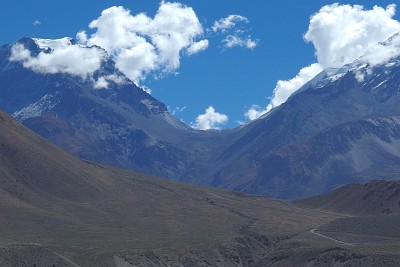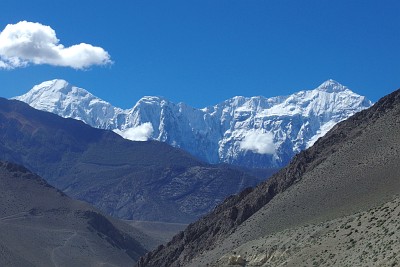From Manang to Kagbeni
(vero;2017-Feb-28)
This leg of the trail is an other highlight with the crossing of Thorong La and the stunning landscape of Lower Mustang around Muktinath and Kagbeni.
We have a few panoramas of the ascent to Thorong La.
From Manang to Kagbeni (5 days, 26 Sept 2016 to 30 Sept 2016)
- 26-27 Sept: Yak Kharka (4050m) to Muktinath (3800m) via Thorong La (5416m)
- 28-30 Sept: Muktinath (3800m) and Kagbeni (2800m)
26-27 Sept: Yak Kharka (4050m) to Muktinath (3800m) via Thorong La (5416m)
Check our panorama page for a few panoramas taken on the way up to Thorong La.
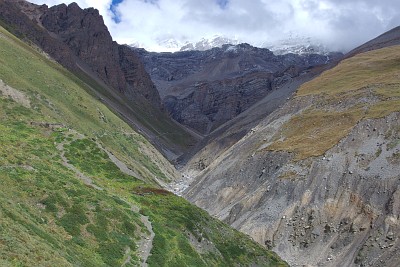 It does not take long to know that we have regained the main trail: there are many trekkers about and among others, a caravan of 70 (yes seventy) Israelis. Fortunately they tend to trek in small groups, most of them with porters, which means that apart from the places where they stop and gather for a break, sometimes obstructing the path, they are not really bothering us during the day. But when we arrive in Yak Kharka, anticipating problems, we make sure to avoid the big lodges! We stop in the first one; it is a bit basic with only 4 rooms and we hope rightfully that they will not stop there.
It does not take long to know that we have regained the main trail: there are many trekkers about and among others, a caravan of 70 (yes seventy) Israelis. Fortunately they tend to trek in small groups, most of them with porters, which means that apart from the places where they stop and gather for a break, sometimes obstructing the path, they are not really bothering us during the day. But when we arrive in Yak Kharka, anticipating problems, we make sure to avoid the big lodges! We stop in the first one; it is a bit basic with only 4 rooms and we hope rightfully that they will not stop there.
The route up to Thorong Phedi the next day is fairly easy, ascending steadily with a few land slides but nothing really tricky. We trek in the company of a young German girl, Sophia, and time flies as we chat all the way. The sky is cloudy as we start but the weather gets better during the day and we can see Gangapurna in the afternoon.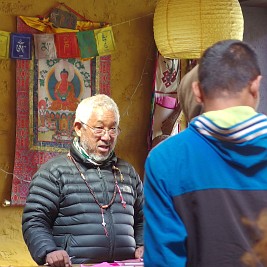
We arrive early and are amazed: the old lodge has expanded with the addition of new sleeping quarters and a huge dining room. There is also now competition with some new lodges next to it. We decide to stay at the old lodge as we did before. This is our third stay in Thorong Phedi and as we tell this to the lodge owner he gets friendly and talkative: this is his lodge, the first ever in this location. He has built it and been in charge since the beginning, so we have most probably already met twice, although neither of us can remember. He is of course not pleased about the newly built Thorong Phedi High Camp, 400 meters higher, a huge lodge which shortens the ascent to the pass but has the disadvantage of being at higher altitude and thus more dangerous for trekkers suffering of altitude sickness. His lodge is filling rapidly as the Israelis start to invade the place. And this is the beginning of a really unpleasant evening: those guys are noisy, inconsiderate of other trekkers, rude with the staff and indisciplined. Although cooking is expressively not allowed in the dining room they hide gas burners under the tables and brew their tea or noodle soups. They have a guitar and a flute and when they find the drums of our host they start playing some kind of music and singing loud without any regard for the rest of the guests. There are not many of us anyway: some have retreated to their sleeping bags and we are 8 or 10 others in a corner trying to have a discussion above the noise level. We are happy when our host finally intervenes and reclaims angrily his drums before admonishing them to keep quiet.
Since most of us will leave early tomorrow, everybody has to pay in the evening and it gets very entertaining to watch the Israelis: many of them disagree with the price and want to bargain. A woman even tries to dodge a dhal bhat with the argument that yes, she had one at 3.30 when she arrived, but the second one at 7.30 was a refill of the first one! We can see our host getting more and more nervous and trying to keep calm. He tells us afterwards that he has never experienced such a thing in 35 years Thorong Phedi… But to be frank, we think that it was not all that bad for him and that he has made a very good business that evening…
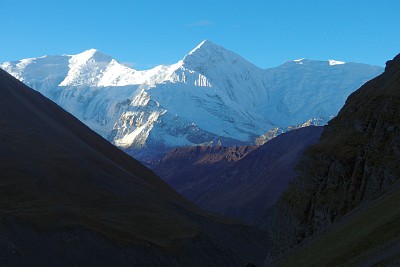
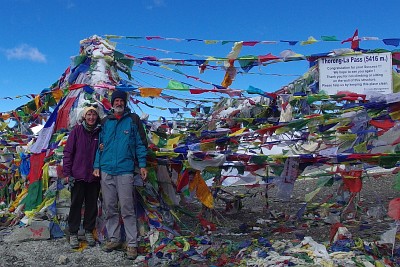 We start fairly late (6 am) the next morning and are nearly the last ones to leave the lodge. We are lucky as the weather is nice with blue sky and views of the surrounding mountains. The climb to the pass is easy for us (easier as Larkya La): we are well acclimatised and go at a steady and regular pace overtaking many trekkers on the way. We arrive at 9.45 am and make a longer break at the pass, explore the nearby lake and are as fascinated by the sudden change of landscape on the other side as we were back in 1995: the views on Muktinath and Lower Mustang are dramatic, stunning and unforgettable.
We start fairly late (6 am) the next morning and are nearly the last ones to leave the lodge. We are lucky as the weather is nice with blue sky and views of the surrounding mountains. The climb to the pass is easy for us (easier as Larkya La): we are well acclimatised and go at a steady and regular pace overtaking many trekkers on the way. We arrive at 9.45 am and make a longer break at the pass, explore the nearby lake and are as fascinated by the sudden change of landscape on the other side as we were back in 1995: the views on Muktinath and Lower Mustang are dramatic, stunning and unforgettable.
We arrive in Ranipauwa, the lodge settlement near Muktinath, at 2 pm and after a good wash stroll through the place. We have no hurry as we will stay an other day to explore the surroundings and the temple area. We take leave of two young Israeli women (nothing to do with the horrible group!) who are continuing tomorrow to Kagbeni: we saw them for the first time in Upper Pisang and had many interesting and pleasant discussions with them in Tilicho and Thorong Phedi. We will miss them!
Don't forget to check our panorama page for a few panoramas taken on the way up to Thorong La.
28-30 Sept: Muktinath (3800m) and Kagbeni (2800m)
We have a photo gallery with pictures of the sensational time we had in Muktinath and Kagbeni and also some panoramas of Lower Mustang.
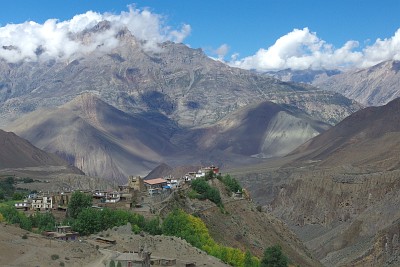 We spend a nice relaxing day in Muktinath. We are the only guests in our lodge and have a late start, taking up the sun on the roof top. Our hostess is also here with her naked 18-month-old daughter: she massages her with oil thoroughly for good 20 minutes and let her play in the sunshine. The little girl enjoys this treatment very much.
We spend a nice relaxing day in Muktinath. We are the only guests in our lodge and have a late start, taking up the sun on the roof top. Our hostess is also here with her naked 18-month-old daughter: she massages her with oil thoroughly for good 20 minutes and let her play in the sunshine. The little girl enjoys this treatment very much.
We go to Jharkot, an half hour walk from Muktinath. It is an old medieval village on a rock spur with the remains of a fortress, a gompa and many ancient houses. We spend a lot of time exploring; there has been a death in the village and many people are gathered in the community hall near the gompa. They are cooking 70 kilos rice in a huge pot until it becomes sticky. They then take a heap of rice and shape it into a “cannon ball”: one for each household in the village.
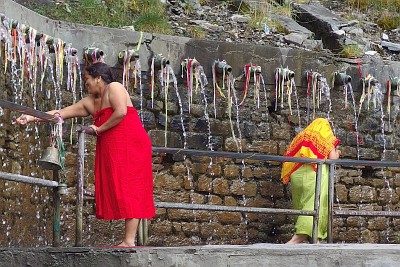 We stroll back to Muktinath and spend the afternoon in the temple dedicated to Vishnu. Many pilgrims come here to bath in the holy waters flowing through 108 spouts shaped in the form of a bull head (the number 108 is a symbolic number in Hinduism). We are lucky to be here at the time of Pitru Paksha, an important Hindu festival honouring ancestors, a time when devotees show their gratitude to the previous generations and the role they played in making them what they are. This is the first time that we see pilgrims actually bathing at the Muktinath temple and we stay for a long time watching the action and discussing with some of them. These are full families, young and old, who come here for puja: they arrive by bus or jeep in Ranipauwa and from there either hire a mule or walk to the temple in Muktinath.
We stroll back to Muktinath and spend the afternoon in the temple dedicated to Vishnu. Many pilgrims come here to bath in the holy waters flowing through 108 spouts shaped in the form of a bull head (the number 108 is a symbolic number in Hinduism). We are lucky to be here at the time of Pitru Paksha, an important Hindu festival honouring ancestors, a time when devotees show their gratitude to the previous generations and the role they played in making them what they are. This is the first time that we see pilgrims actually bathing at the Muktinath temple and we stay for a long time watching the action and discussing with some of them. These are full families, young and old, who come here for puja: they arrive by bus or jeep in Ranipauwa and from there either hire a mule or walk to the temple in Muktinath.
First comes the bathing. The men undress in boxer shorts, the women wriggle out of their clothes behind drapes which they then roll around them and, some of them holding a towel over their head, they start running under the freezing cold water flowing out of the 108 taps. To top it all, they then have to immerse themselves in two pools. The atmosphere is very good and happy and there is much banter going on as they dry themselves and change clothes.
Cleansed and purified, they then arrange the offerings they have brought with them on trays or small baskets and go to the main shrine for the puja ceremony. Many also make a money donation to the temple (for which they get a receipt).
There are clouds in the sky as we leave the next morning for Kagbeni but we still have good views down valley throughout the day, unfortunately not on Dhaulagiri or Thorong La. We decide to take the trail which is on the other side of the valley instead of walking along the main dirt road. This trail, passing through the villages of Chengur and Jhong, has also turned into a dirt road but it is hardly used and we see only one jeep during the whole day. The walking is easy and it is perfect to soak up the grandiose landscape around us. We leave the road before reaching Kagbeni and go up a hill. This is well worth the effort as we get great views on Kagbeni below us and the Kali Gandaki valley, both down- and upstream.
We arrive fairly early in Kagbeni and we can't believe our eyes: the village is packed with people (Nepalis) and all the lodges where we ask for a room are full. We finally discover a small lodge with three rooms and they have vacancies. We are relieved as we want to spend the next day in Kagbeni and did not feel like going down to Jomson today. We soon understand what's going on: it has to do with Pitru Paksha. The festival is one week long and today is the last day. We ask pilgrims for more details.
Kagbeni is a particularly auspicious place as it is located at the confluence of the Kali Gandaki and the Jhong Khola which are both holy rivers. The first for flowing eventually into the Ganges near Patna in India, and the second one for the same reason and doubly holy as its waters have passed through the 108 spouts of Muktinath before reaching the Kali Gandaki. This makes Kagbeni an ideal place for worship and being in Mustang and in a fantastic landscape, it doubles as a great holiday destination much more so since the coming of the road has made Kagbeni easily accessible.
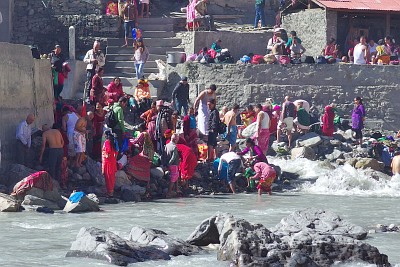 As explained to us and as we observed, the proceedings are as follows: the pilgrims come to Kagbeni and bath in the river. There they make puja and send leaves laden with offerings downstream. Men who have lost their father are expected to shave their hair (although not all of them do it) and many do it on the spot.
As explained to us and as we observed, the proceedings are as follows: the pilgrims come to Kagbeni and bath in the river. There they make puja and send leaves laden with offerings downstream. Men who have lost their father are expected to shave their hair (although not all of them do it) and many do it on the spot.
After the bath it is time for sight seeing and most important, time to look for shaligrams in the river bed. Shaligrams are fossilised shells found specifically in or on the banks of the Kali Gandaki and they are inherent to Vishnu, which means that no Vishnu temple can be built without a shaligram embedded in its walls. No wonder then that everybody dreams to find his own shaligram, or at least a fragment of one, and there are many locals selling the stones in the village.
Next stop after Kagbeni is the visit to the Muktinath temple which is what we witnessed yesterday with further bathing and offering ceremonies. After this everybody starts the journey back home.
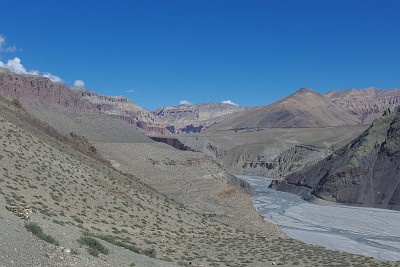 We spend a most entertaining afternoon watching the bustle around us. Buses and jeeps arrive regularly bringing full loads of families carrying big bags. They step out and first thing they do is to go hunting for accommodation. With the lodges full it is not easy and we watch them going from one place to the other. When we come back to our lodge it is also full: two families are here drinking tea in the kitchen and the dining room. One family, consisting of three couples, comes from Nautanda and will sleep in the dining room. They have already arranged mattresses and blankets on the floor, the women sitting or lying on them, the men sitting on chairs. They are well dressed. The men are wearing the typical Nepalese hat (or Topi) and the women are draped in red saris. The other family comprises five people (all wearing glistening woolen hats) and they all sleep in the same double room: three on the bed and two on the floor. The last double room is occupied by an Italian mountain biker who was already here when we arrived and who kindly accepted to share his room for the night with a travelling monk. Full house indeed! As night falls we see villagers scurrying through the dark alleyways, transporting mattresses and blankets from one house to the other in order to help accommodate so many visitors.
We spend a most entertaining afternoon watching the bustle around us. Buses and jeeps arrive regularly bringing full loads of families carrying big bags. They step out and first thing they do is to go hunting for accommodation. With the lodges full it is not easy and we watch them going from one place to the other. When we come back to our lodge it is also full: two families are here drinking tea in the kitchen and the dining room. One family, consisting of three couples, comes from Nautanda and will sleep in the dining room. They have already arranged mattresses and blankets on the floor, the women sitting or lying on them, the men sitting on chairs. They are well dressed. The men are wearing the typical Nepalese hat (or Topi) and the women are draped in red saris. The other family comprises five people (all wearing glistening woolen hats) and they all sleep in the same double room: three on the bed and two on the floor. The last double room is occupied by an Italian mountain biker who was already here when we arrived and who kindly accepted to share his room for the night with a travelling monk. Full house indeed! As night falls we see villagers scurrying through the dark alleyways, transporting mattresses and blankets from one house to the other in order to help accommodate so many visitors.
We retire early after our evening dhal bhat as it is obvious that the family in the dining room is waiting for everybody else to leave the room so that they can go to sleep.
They have indeed a full day in front of them: the next morning everybody is woken up at 4.20 am by the lodge owners who come banging on the doors (including ours). We can hear them getting ready and there is a lot of bathroom traffic. It suddenly gets all quiet at 6 am: they are gone. We stroll out of the lodge at 9:00 am and head for the river banks where many people are bathing. A very colourful spectacle and we spend a long time watching the scene and going from one group to the other.
After a while we decide to go a bit up valley to the village of Tiri. This is the last settlement which can be reached without a trekking permit for Mustang. We go up the hill above the village where there is a gompa offering sensational views on the Kali Gandaki valley. We can see Thorong La and follow the way to Muktinath while the Nilgiris are in full splendour under the blue sky. We find peach trees around the gompa: the fruits are ripe and delicious. We love the place.
As we come back to Kagbeni around midday there is hardly anybody at the river: they are all waiting patiently at the road head for a bus or a jeep to take them to Muktinath. What an anticlimax compared to yesterday: the village is empty and quiet, nearly dead. We wander around the alleyways mostly meeting strolling calves, a herd of sheep passes through the village, it all feels very rural. The second evening in our lodge is most pleasant and we keep fond memories of our hostess: her name is Gunjang, she is 61 years old and takes great care of us. We get an apple and some popcorn as we wait for our dinner and when we want to leave the following day she does not let us out of the house without having drunk some Tibetan tea and eaten a bowl full of tsampa, everything offered as a mark of hospitality: she does not want any money for it.
Don't forget to check our photo gallery for pictures of the festival and the landscape. Look also for our panoramas of Lower Mustang.
Go back to Side Trip to Tilicho Lake or go on to From Kagbeni to Pokhara
$ updated from: Around Annapurna.htxt Mon 28 Apr 2025 14:55:29 trvl2 — Copyright © 2025 Vero and Thomas Lauer unless otherwise stated | All rights reserved $




